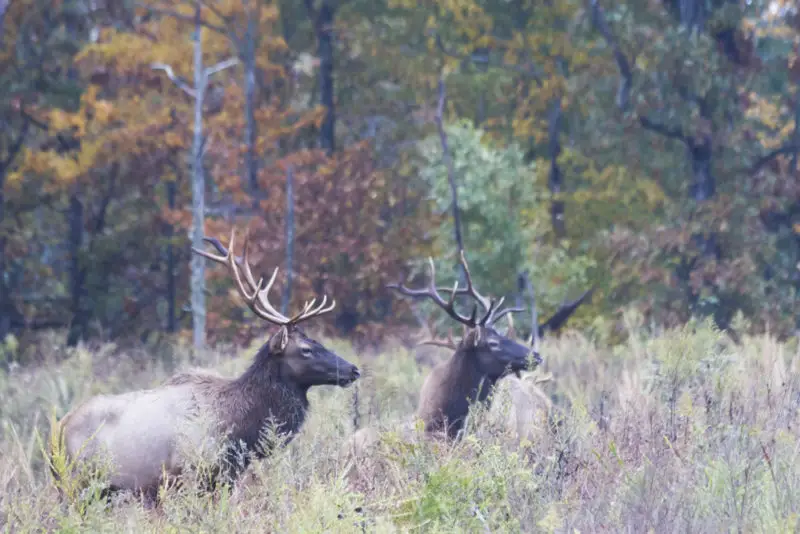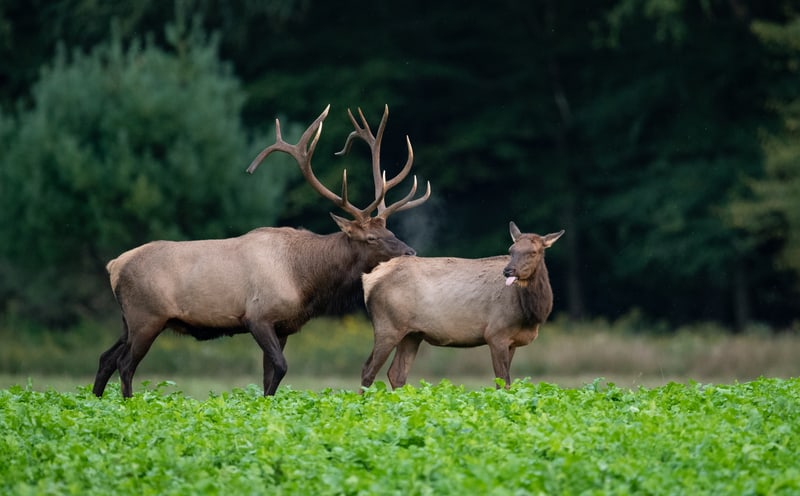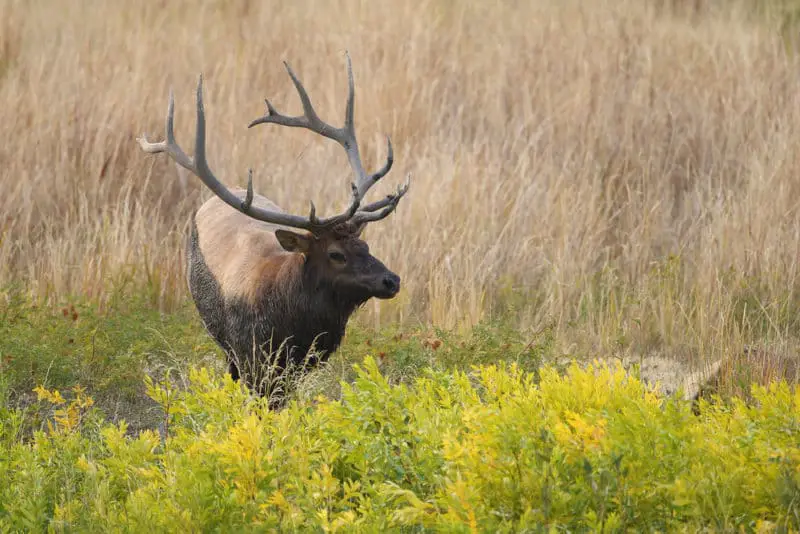Through the years, elk have gone completely missing from the state of Virginia twice. Today though, Virginia has a herd of over 250 wild elk. The state’s elk herd exists today due to the planning and hard work of the Virginia Department of Wildlife Resources, “formerly the Virginia Department of Game and Inland Fisheries,” along with dedicated partners like the Rocky Mountain Elk Foundation.
In the time before Europeans colonized North America, elk or wapiti ranged throughout what is now the eastern United States. At that time, there were elk throughout Virginia. However, the densest populations of them were west of the Blue Ridge Mountains. However, elk and civilization didn’t mix well. Lack of regulations and over hunting coupled with habitat loss both took an unsustainable toll. Consequently, the population of elk in eastern North America plummeted in the 1700s and 1800s. The eastern elk sub-species became extinct in the late 1800s. Colonel G. Tuley killed the last native elk in Virginia in 1855 in Clarke County. Twenty-two years later, the last eastern elk was killed in Pennsylvania in 1877.
Reintroduction of elk in the early 20th century
Soon after the creation of the Virginia Department of Game and Inland Fisheries in 1916, it became an aim to re-establish Virginia’s elk population. In the early 1900s, the VDGIF and owners of private land released elk in 15 counties across the state of Virginia. A good share of these elk had been captured in Yellowstone national park.
This population failed to thrive. By 1970, elk were again expatriated from the state of Virginia. Numerous factors played into this, such as poor habitat selection, poaching, and over hunting.

Second reintroduction of elk
In 1997, the Kentucky Department of Fish and Wildlife Resources embarked on a 5-year plan to restore elk to the eastern 1/3 of their state. Subsequently, they released a total of 1540 elk into Knot, Harlan, Leslie, Letcher, Martin, Perry, and Pike counties.
Given the close proximity of the release to their state boundaries, Virginia Department of Wildlife Resources officials fully expected elk to cross the border from Kentucky into Virginia. With this in mind, they collaborated with Virginia Tech to conduct a study on the feasibility of restoring elk back into the commonwealth of Virginia.
The study determined that there was quality elk habitat available in the southwestern portion of the state. However, the likelihood of human-elk conflict was high. This, along with the possibility of introducing elk born disease into the state, halted any elk restoration effort for the time being.
By the year, 2,000 elk were beginning to cross the border from eastern Kentucky into southwestern Virginia. Initially, the Virginia Department of Wildlife Resources tried trapping the wayward elk and returning them to Kentucky. However, this proved to be an impractical and costly practice. After that, they decided to allow hunters to harvest elk of either sex during the white-tailed deer season under their deer license.
In spite of the aforementioned measures, several small elk herds still established themselves within the state.
Between 2012 and 2014, the Virginia Department of Game and Inland Fisheries,” now the Virginia Department of Wildlife Resources,” relocated a total of 71 adult elk and 4 calves from Kentucky to southwestern Virginia in Buchanan County. Today, those elk, plus the ones that migrated over the border, naturally have increased into a herd of 250+ animals.

Elk management zone
There is some opposition to elk restoration in some of western Virginia’s counties. Therefore, the Virginia elk management zone is restricted to only Buchanan, Dickenson, and Wise Counties. Within the elk management zone, all elk hunting is prohibited except during the state’s prescribed elk season. The first elk season within the elk management zone will take place in the fall of 2022. Outside of the elk management zone, hunters can harvest any elk during the state’s deer season with their deer tag.
Elk viewing opportunities in southwest Virginia
Your best chances to view elk will come in Buchanan County. Here’s a link to information on the Virginia Bird and Wildlife Trail’s Lonesome Pine Loop. Take this route if you’re searching for elk viewing opportunities.
The Breaks Interstate Park
The Breaks Interstate Park is 1 of only 2 interstate parks in the nation. It lies primarily in southwest Virginia but also crosses the state line into Kentucky.
The park offers elk tours on select dates in March, April, May, August, September, and October.
Southern Gap Outdoor Adventure Center
The Southern Gap Outdoor Adventure Center offers seasonal elk tours in conjunction with the Southwest Virginia Sportsman’s Club and the Southwest Virginia Chapter of the Rocky Mountain Elk Foundation.
The elk viewing schedule for the fall of 2022 is as follows. August 20 and 27; September 2, 3, 9, 10, 16, 17, and 30 at 5 p.m. October 1, 15, 21, 22, 28, and 29 at 4 p.m.
The tours will be conducted from buses with limited seating, so you have to make a reservation. Also, the tours originate at the Southern Gap campground. For more information or to make a reservation call Southern Gap @ 276-244-1111
Elk Cam
The Virginia Department of Game and Inland Fisheries “now the Virginia Department of Wildlife Resources,” has placed an elk live viewing camera at the top of the 35-foot-tall viewing tower that overlooks a valley where elk typically come into view in Vansant, Virginia.
To quote elk project leader David Kalb, he “envisioned a viewing camera to provide an opportunity for people at long distances to witness the elk restoration rebounding in the southwest corner of Virginia.” Source
Leon Boyd is the chairman of the Rocky Mountain Elk Foundation (RMEF) Southwest Virginia Chapter as well as a board member of the Virginia Department of Wildlife Resources. He is optimistic that the state’s successful restoration of elk will draw visitors into southwest Virginia. He points to the Cataloochee Valley in North Carolina as an example of the economic benefits elk can bring to an area. Source He also sees the elk cam as a means to this end.
The elk cam will run annually from mid-August through November. In mid to late August, the cows and calves begin to herd up with the bulls, leading up to the rut or mating season.
The elk rut peaks in late September through early October. This is the most exciting time to watch the elk cam. Grunting bugling bulls battle each other as they attempt to gather and hold their own harem of cows.
Here is the link to the elk cam. These are free ranging elk that move from cover to feed. They probably won’t be in the open or in front of the camera 24/7 but keep checking back.
Virginia’s first elk hunt
The Commonwealth of Virginia’s first-ever managed elk hunt in its elk management zone, which is anywhere within Buchanan, Dickenson, and Wise counties, will open up on the 10th anniversary of its elk restoration program. The hunt will run from October 8th through October 14th of 2022.
The state issued 6 elk tags for bull elk within the elk management zone. 5 of the tags were issued through the elk hunt lottery. They sold the 6th one through a raffle.
Hunters can legally take any elk in any area outside of Dickinson County, Wise County, and Buchanan County during the state’s white-tailed deer season with their deer tag.
Recent Posts
The only venomous snakes in Washington State are Northern Pacific Rattlesnakes. The Northern Pacific Rattlesnake (Crotalus oreganus oreganus) is a sub-species of the Western Rattlesnake. Anyone...
Skunks are not classified as true hibernators. But they go into a state of torpor when the weather gets cold. Skunks are light sleep hibernators, along with opossums, bears, and raccoons. ...

